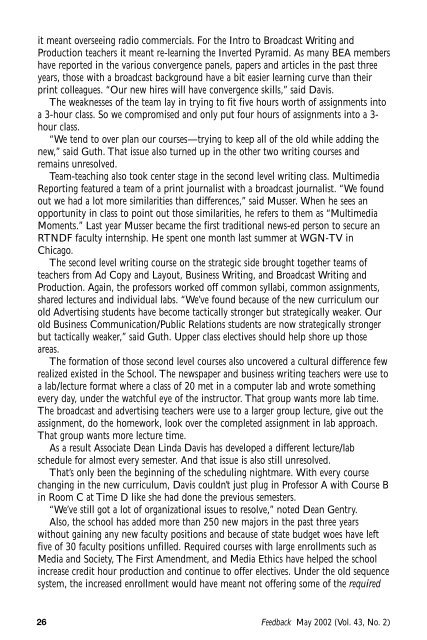Feedback May 2002 (Vol 43 No 2)
Feedback May 2002 (Vol. 43, No. 2) - Broadcast Education ...
Feedback May 2002 (Vol. 43, No. 2) - Broadcast Education ...
- No tags were found...
Create successful ePaper yourself
Turn your PDF publications into a flip-book with our unique Google optimized e-Paper software.
it meant overseeing radio commercials. For the Intro to Broadcast Writing andProduction teachers it meant re-learning the Inverted Pyramid. As many BEA membershave reported in the various convergence panels, papers and articles in the past threeyears, those with a broadcast background have a bit easier learning curve than theirprint colleagues. “Our new hires will have convergence skills,” said Davis.The weaknesses of the team lay in trying to fit five hours worth of assignments intoa 3-hour class. So we compromised and only put four hours of assignments into a 3-hour class.“We tend to over plan our courses—trying to keep all of the old while adding thenew,” said Guth. That issue also turned up in the other two writing courses andremains unresolved.Team-teaching also took center stage in the second level writing class. MultimediaReporting featured a team of a print journalist with a broadcast journalist. “We foundout we had a lot more similarities than differences,” said Musser. When he sees anopportunity in class to point out those similarities, he refers to them as “MultimediaMoments.” Last year Musser became the first traditional news-ed person to secure anRTNDF faculty internship. He spent one month last summer at WGN-TV inChicago.The second level writing course on the strategic side brought together teams ofteachers from Ad Copy and Layout, Business Writing, and Broadcast Writing andProduction. Again, the professors worked off common syllabi, common assignments,shared lectures and individual labs. “We’ve found because of the new curriculum ourold Advertising students have become tactically stronger but strategically weaker. Ourold Business Communication/Public Relations students are now strategically strongerbut tactically weaker,” said Guth. Upper class electives should help shore up thoseareas.The formation of those second level courses also uncovered a cultural difference fewrealized existed in the School. The newspaper and business writing teachers were use toa lab/lecture format where a class of 20 met in a computer lab and wrote somethingevery day, under the watchful eye of the instructor. That group wants more lab time.The broadcast and advertising teachers were use to a larger group lecture, give out theassignment, do the homework, look over the completed assignment in lab approach.That group wants more lecture time.As a result Associate Dean Linda Davis has developed a different lecture/labschedule for almost every semester. And that issue is also still unresolved.That’s only been the beginning of the scheduling nightmare. With every coursechanging in the new curriculum, Davis couldn’t just plug in Professor A with Course Bin Room C at Time D like she had done the previous semesters.“We’ve still got a lot of organizational issues to resolve,” noted Dean Gentry.Also, the school has added more than 250 new majors in the past three yearswithout gaining any new faculty positions and because of state budget woes have leftfive of 30 faculty positions unfilled. Required courses with large enrollments such asMedia and Society, The First Amendment, and Media Ethics have helped the schoolincrease credit hour production and continue to offer electives. Under the old sequencesystem, the increased enrollment would have meant not offering some of the required26<strong>Feedback</strong> <strong>May</strong> <strong>2002</strong> (<strong>Vol</strong>. <strong>43</strong>, <strong>No</strong>. 2)
















